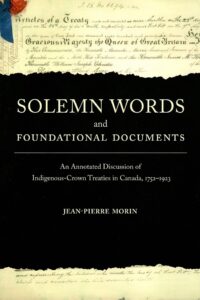Book review: Solemn Words and Foundational Documents: An Annotated Discussion of Indigenous-Crown Treaties in Canada, 1752-1923
Solemn Words and Foundational Documents: An Annotated Discussion of Indigenous-Crown Treaties in Canada, 1752-1923 is a marvellous collection that provides a thought-provoking and educational exploration of eight key treaties from across Canada between Indigenous nations and the Crown. In eight chapters, Morin explores the Peace and Friendship Treaties, 1725-1779; Huron-British Treaty, 1760; Rice Lake Treaty, 1818; Robinson-Huron Treaty, 1850; Saanich Treaties, 1852; Treaty no.6, 1876; Treaty no.8, 1899; and William Treaties, 1923. Morin’s introduction and discussion of each treaty is followed by a set of relevant documents as well as questions for discussion, brief biographies of some of the main players for each treaty, and suggested further reading. Each well-nuanced discussion and document set provides readers with a pathway to greater understanding of treaty-making, implementation (or lack thereof), and contemporary impacts.
While Morin’s text is aimed at the post-secondary classroom market, it is a useful collection to read for personal interest. The documents, cast of characters, exploratory essays, and discussion questions provide readers with the opportunity to expand their learning and understanding by reading the actual documents associated with the treaties. For instance, the Peace and Friendship Treaties chapter includes Mi’kmaq oral testimony about the 1752 treaty recorded in 1928, the 1752 Treaty document, and text from the Council held in Halifax in 1752, and you can see how oral testimony passed the Mi’kmaq understanding of the treaty across generations. It also ably shows that the oral testimony is supported by the written text and how both played a role in the Supreme Court of Canada’s Marshall Decision in 1999. Similarly, for the Robinson-Huron Treaty of 1850, Morin provides an explanatory essay, the treaty, Robinson’s report, Indigenous correspondence to Indian Affairs concerning settler trespass and treaty violations post-1850, as well as an excerpt from the Bear Island Decision of 1991. Together, these materials provide readers with the opportunity to explore and understand the impact of the treaty, Anishinaabeg understandings, as well as how the courts have reacted to treaty claims of Teme-Augama Anishnabai. This pattern of document inclusion provides readers the opportunity to come to their own understandings and do more than simply ‘take someone’s word for it.’ In short, the reader can understand how these oral and written documents shaped and were shaped by treaty-making, subsequent understandings, and their continued importance in contemporary Canada.
Overall, Solemn Words is an excellent text for college and university classrooms that would not be out of place in a high school classroom or a home library. Morin’s writing is educational, edifying, and engaging, while the included documents and questions serve to engage and encourage understanding on the importance of both the oral and written record of treaty. Solemn Words is an important pedagogical work that is accessible to a variety of audiences. I do hope that Morin will update treaty sections in future editions as Canadian courts and Indigenous peoples work through treaty understandings and implementations – specifically, I am hoping he includes materials relating to the current Robinson treaties annuity’s case. Nevertheless, Solemn Words is really a must-read if you are interested in learning more about treaties.
Jean-Pierre Morin, Solemn Words and Foundational Documents: An Annotated Discussion of Indigenous-Crown Treaties in Canada, 1752-1923. Toronto: University of Toronto Press, 2018.
ISBN: 9781487594459



